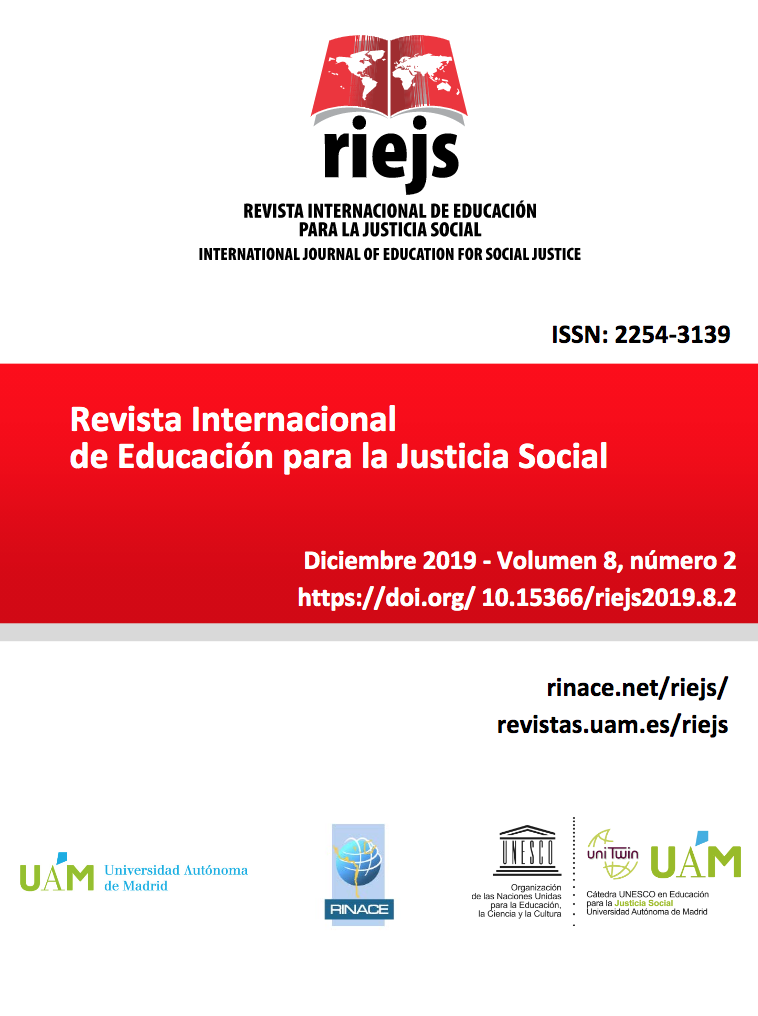Participatory Research with Young People with Visual Disabilities: When the Exclusion and Inclusion Stories Take to the Streets
Keywords:
Participant research, Blindness, Social exclusion, Universal education, Social justice.Abstract
In order to visibilize the reality of people with visual disabilities, a Human Library is carried out as an innovative and participatory methodological strategy. A group of adolescents with some visual disability, participate sharing through their narratives their experiences and experiences related to disability and the social response. In this work, the voices of two teenagers with blindness who choose for their oral story the narration of their school career from childhood to post-compulsory education are analyzed. The participatory research strategies used during the celebration of the Human Library as well as the records of the previous discussion groups and the participant observation. The analysis make possible to identify the more recurrent educational barriers in the history of young people related to the climate of the schools, the methodologies and the role of teachers, but also makes possible identify levers of change that invite us to rethink the educational practices of school inclusion and exclusion.
Downloads
References
Abendaño, C. y Díaz, Y. (2014). El proceso de integración educativa desde la perspectiva de cinco jóvenes universitarios con discapacidad visual de Concepción. Estudios Pedagógicos, 40(2), 45-64. https://doi.org/10.4067/S0718-07052014000300003
Ainscow, M. (2004). El desarrollo de sistemas educativos inclusivos: ¿Cuáles son las palancas de cambio? Journal of Educational Change, 5(4), 1-20.
Ainscow, M. y Messiou, K. (2018). Engaging with the views of students to promote inclusion in education. Journal of Educational Change, 19(1), 1-17. https://doi.org/10.1007/s10833-017-9312-1
Alnahdi, G. H. (2019). Disabilities in schools: Children´s attitudes towards peers with disabilities in Saudi Arabia. Research in Developmental Disabilities, 85, 1-7. https://doi.org/10.1016/j.ridd.2018.10.004
Anyon, J. (2006) What count as educational research?: Notes towards a new paradigm. En G. Ladson-Billings y W. Tate (Eds.), Education research in the public interest: Social justice, action, and policy (pp. 17-26). Nueva York, NY: Teachers College Press.
Banks, J. y McCoy, S. (2017). An Irish solution? Questioning the expansion of special classes in an era of inclusive education. The Economic and Social Review, 48(4), 441-461.
Booth, T. (2011). The name of the rose: Inclusive values into action in teacher education. Prospects, 41, 303-318. https://doi.org/10.1007/s11125-011-9200-z
Booth, T. (1998). El sonido de las voces acalladas: Cuestiones acerca del uso de los métodos narrativos con personas con dificultades de aprendizaje. En L. Barton (Comp.), Discapacidad y sociedad (pp. 253-271). Madrid: Morata.
Booth, T. y Ainscow, M. (2011). Index for inclusion: Developing learning and participation in schools Bristol: Centre for Studies in Inclusive Education.
Metsiou, K., Papdopoulos, K. y Agaliotis, I. (2011). Adaptive behavior of primary school students with visual impairments: The impact of educational settings. Research in Developmental Disabilities, 32, 2340-2345. https://doi.org/10.1016/j.ridd.2011.07.030
Muñoz, M. L., López, M. y Assaél, J. (2015). Concepciones docentes para responder a la diversidad ¿Barreras o recursos para la inclusión educativa? Psicoperspectivas, 14(3), 68-79. https://doi.org/10.5027/psicoperspectivas-Vol14-Issue3-fulltext-646
Nind, M. (2014). What is inclusive research? Londres: Bloomsbury.
Parrilla, A., Susinos, T., Gallego, C. y Martínez, B. (2017). Revisando críticamente cómo investigamos en educación inclusiva: Cuatro proyectos con un enfoque educativo y social. Revista Interuniversitaria de Formación del Profesorado, 89(2), 145-156.
Parrilla, A., Doval, M. I., Martínez, E., Muñoz, M. A., Raposo, M. y Zabalza, M. (octubre, 2011). Un mapa de preocupaciones y barreras sobre la educación inclusiva. Comunicación presentada en el I Congreso internacional de educación especial. Universidad de Cádiz.
Ravitch, S. (2014). The transformative power of taking and inquiry stance on practice: Practitioners research and narrative counter-narrative. Perspectives on Urban Education, 11(1), 5-10.
Rip, A. (2016). The clothes of the emperor. An essay on RRI in and around Brussels. Journal of Responsible Innovation, 3(3), 290-304. https://doi.org/10.1080/23299460.2016.1255701
Senge, P. M. (1989). The fifth discipline: The art and practice of the learning organization. Londres: Century.
Sierra Martínez, S., Fiuza Asorey, M. y Parrilla, A. (2019). Nuevas herramientas metodológicas de investigación participativa: Las bibliotecas humanas. En B. Tejero Claver, O. Bernad Cavero y C. Lechuga Jiménez (Ed.), Investigando en contenidos de vanguardia (pp. 503-516). Madrid: Gedisa.
Walmsley, J. y Johnson, K. (2003). Inclusive research with people with learning disabilities: Past, present, and futures. Londres: Jessica Kingsley Publisher.
Zorakhovich, V., Vladimirovna, G. y Nikolaevna, I. (2017). The impact of the institucional learning environments on the development of self-attitude in pupils with vision deficiency. Journal of Pharmaceutical Sciences and Research, 9(10), 1912-1917.

